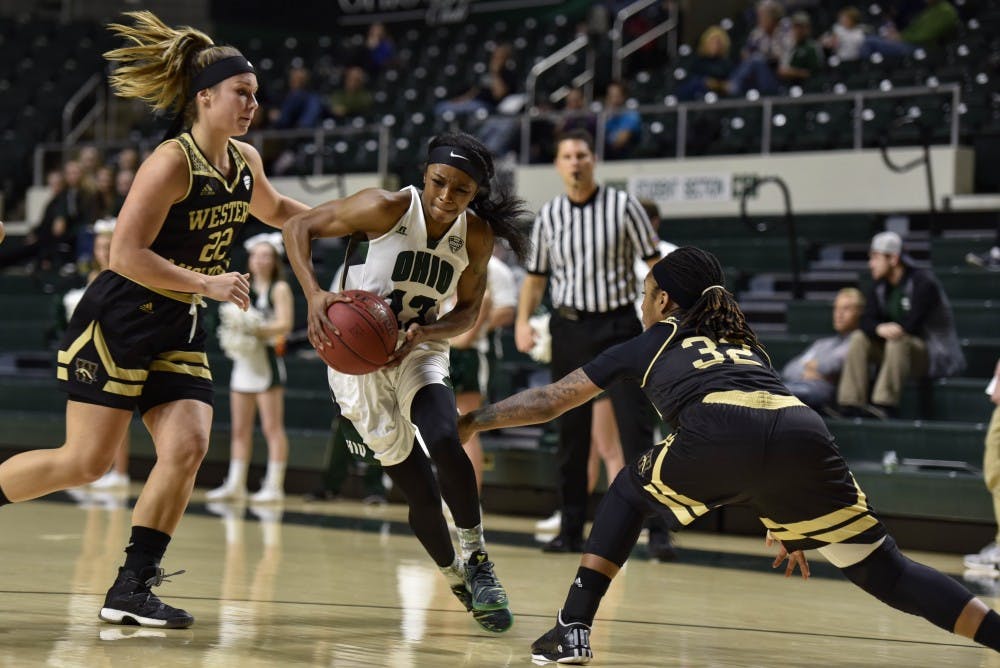OXFORD — In its first game without Jasmine Weatherspoon, Ohio won for the fourth-consecutive time, 79-62 against Miami on Saturday afternoon.
With the Bobcats' next four opponents having a combined 22-7 in the Mid-American Conference, a potential season-defining stretch is coming up for Ohio.
Here are three components of Saturday’s game that stood out.
Jasmine Weatherspoon’s absence: felt and not felt
In their first full game without their best rebounder, the Bobcats, also known as the worst rebounding team in the MAC, out-rebounded the RedHawks by 14. Similar to Wednesday against Western Michigan, it took a collective effort to fill Weatherspoon’s rebounding void.
Five players came down with at least four rebounds and all five of them were under six feet tall.
“It’s just gonna have to be a group effort until we get (Weatherspoon) back,” coach Bob Boldon said.
Out-rebounding Miami doesn’t mean that rebounding won’t be an issue going forward — Miami is the second worst rebounding team in the MAC. But it is an encouraging sign to have multiple players doing their part to make up for the loss of Weatherspoon, a senior and starting center.
Weatherspoon’s presence at the rim, however, was obviously lacking in the early moments of Saturday’s game. Miami scored 10 of its 20 first quarter points inside, and Ohio has recorded one block since Weatherspoon went down.
Blocks were not the sole measure for protecting the rim, and the Bobcats did hold the RedHawks to 14 points inside the following three quarters, but Weatherspoon’s athleticism will be hard to replace.
Hannah Boesinger and Yamonie Jenkins: figuring it out.
Both Boesinger and Jenkins have struggled shooting the ball this season. Both are under 30 percent from 3-point range, and Boesinger is shooting 41 percent from the field overall, while Jenkins is shooting 33 percent.
In both of the last two games, though, Jenkins and Boesinger have scored in double figures, and done so efficiently. Jenkins is averaging 13 points per game on 7-of-10 shooting and 3-6 from 3-point attempts the last two games, and Boesinger is averaging a 15 per game on 11-of-22 shooting and 5-11 from 3-point range, including consecutive season highs.
It’s possible that their recent performances are outliers, but Jenkins and Boesinger look more confident shooting the ball, and they feel their confidence normalizing.
“I think we kind of feed off each other’s energy,” Boesinger said. “I see one of (Jenkins’) shots go in and I go ‘Alright, maybe I can hit one too.’ ”
Quiera Lampkins: Continuing to do it all
Lampkins struggled at times against a Miami defense that took chances with Ohio 3-point shooters by having one extra defender inside every time Lampkins drove. She finished the game making all of her last four shots after starting 2-12, but that wasn’t her main contribution.
Lampkins also pulled down 10 rebounds when the Bobcats needed someone to lead the charge in that area the most. Saturday’s double-double was Lampkins’ fifth of the season, and she continued to prove that her worth comes in a variety of forms.
It seems like whenever the Bobcats are struggling, Lampkins can gear her energy toward that, masking any flaw.
Bonus fourth note: The bench!
Past three games for the Ohio bench: 87-25 bench points advantage. Saturday’s game was a 22-12 advantage and was helped by a good run by the end of Boldon’s bench, but Dominique Doseck and Amani Burke outscored the Miami bench by themselves.
Most importantly, it came on the road, where benches tend to struggle. Being able to sustain or extend leads while the starters rest can be the difference in important games down the stretch.






